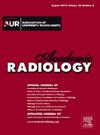利用多中心经动脉化疗栓塞研究的数据评估对比增强超声非放射治疗反应评估LI-RADS v2024。
IF 3.8
2区 医学
Q1 RADIOLOGY, NUCLEAR MEDICINE & MEDICAL IMAGING
引用次数: 0
摘要
依据和目的:肝细胞癌(HCC)局部治疗反应通常使用实体瘤反应评估标准(Modified Response Evaluation Criteria in Solid Tumors)和美国放射学会(ACR)肝脏报告和数据系统(LI-RADS)治疗反应评估(TRA)进行 MRI/CT 评估。本研究旨在评估新的 ACR 对比增强超声(CEUS)非放射 TRA LI-RADS v2024 在经动脉化疗栓塞(TACE)治疗的 HCC 中的诊断性能:这项回顾性观察研究纳入了 87 例接受 TACE 治疗的患者,这些患者来自之前报道过的队列。在治疗后 15 天和 30 天,分别对 68 个和 72 个 HCC 病灶进行了评估。三位具有不同水平 CEUS 经验的盲人放射科医生对图像进行了独立解读。根据 CEUS 非放射 TRA LI-RADSv2024,对肿瘤内部和周围的存活率进行了评估,最终的 TRA 分类如下:TRA-无活力、TRA-有活力和TRA-有活力。采用的参考标准是组织学和影像学的综合结果:分析了 140 个 HCC 病灶。治疗后 15 天,TR-Viable 分类的灵敏度(SN)、特异度(SP)、阳性预测值(PPV)、阴性预测值(NPV)和准确度分别为 72.5-94.3%、72.2-86.4%、86.8-91.4%、65.6-86.7%、76.9-86.8%。治疗后 30 天,TR-Viable 分级的 SN、PPV 和 NPV 分别下降了 65.9-84.2%、85.7-90.6% 和 59.5-73.9%,而 SP 则上升了 80.0-88.0%。Kappa值介于0.557-0.730之间,表明中度到高度一致:结论:CEUS 非放射 TRA LI-RADS 是检测接受 TACE 治疗的病变中存活肿瘤的可靠工具,不同读者之间具有可重复性。本文章由计算机程序翻译,如有差异,请以英文原文为准。
Evaluation of the Contrast-Enhanced Ultrasound Nonradiation Treatment Response Assessment LI-RADS v2024 Using Data From a Multi-Center Transarterial Chemoembolization Study
Rationale and Objective
Hepatocellular carcinoma (HCC) locoregional treatment response is commonly evaluated using the Modified Response Evaluation Criteria in Solid Tumors and the American College of Radiology (ACR) Liver Reporting and Data System (LI-RADS) Treatment Response Assessment (TRA) for MRI/CT. This study aims to evaluate the diagnostic performance of the new ACR contrast-enhanced ultrasound (CEUS) Nonradiation TRA LI-RADS v2024 in HCC treated with transarterial chemoembolization (TACE).
Materials and Methods
This retrospective observational study included 87 patients treated with TACE from a previously reported cohort. At 15- and 30-days post-treatment, 68 and 72 HCC lesions were evaluated. Three blinded radiologists with different levels of CEUS experience interpreted the images independently. According to CEUS Nonradiation TRA LI-RADSv2024, both intralesional and perilesional tumor viability were evaluated and final TRA categories were as follows: TR-Nonviable, TR-Equivocal, and TR-Viable. The reference standard used was a composite of histology and imaging.
Results
140 HCC lesions were analyzed. At 15 days post-treatment, the sensitivity (SN), specificity (SP), positive predictive value (PPV), negative predictive value (NPV), and accuracy of TR-Viable classification ranged from 72.5–94.3%, 72.2–86.4%, 86.8–91.4%, 65.6–86.7%, 76.9–86.8%, respectively. At 30 days post-treatment, the SN, PPV, and NPV of TR-Viable classification decreased, ranging from 65.9–84.2%, 85.7–90.6%, and 59.5–73.9%, respectively, while the SP increased, ranging from 80.0–88.0%. Kappa values ranged from 0.557–0.730, indicating moderate to substantial agreement.
Conclusion
CEUS Nonradiation TRA LI-RADS is a reliable tool for the detection of viable tumors in lesions treated with TACE and demonstrates reproducibility across readers.
求助全文
通过发布文献求助,成功后即可免费获取论文全文。
去求助
来源期刊

Academic Radiology
医学-核医学
CiteScore
7.60
自引率
10.40%
发文量
432
审稿时长
18 days
期刊介绍:
Academic Radiology publishes original reports of clinical and laboratory investigations in diagnostic imaging, the diagnostic use of radioactive isotopes, computed tomography, positron emission tomography, magnetic resonance imaging, ultrasound, digital subtraction angiography, image-guided interventions and related techniques. It also includes brief technical reports describing original observations, techniques, and instrumental developments; state-of-the-art reports on clinical issues, new technology and other topics of current medical importance; meta-analyses; scientific studies and opinions on radiologic education; and letters to the Editor.
 求助内容:
求助内容: 应助结果提醒方式:
应助结果提醒方式:


